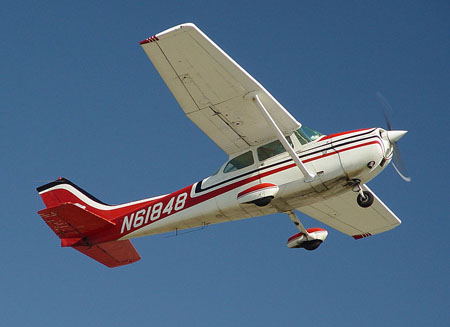As with most fields of photographic endeavour, a vast range of approaches and possibilities exists. In most cases the choice of aircraft, equipment and approach will be heavily influenced by cost.
The cheapest and most easily arranged approach is to find a pilot at a local airfield who is prepared to undertake the required aerial photography flight, although pilots who have experience of working with photographers are always preferable. Note that if a payment is made to the pilot he or she must have a commercial license and the aircraft should meet the appropriate requirements for commercial flights.
Light high-wing aircraft, such as small single-engine Cessna's, are flown from countless local airfields and there are often pilots prepared to fly paying passengers. Given a choice, a Cessna 177RG Cardinal is an ideal aircraft because it has a retracting undercarriage and no wing struts to obscure views. In addition to the obvious attention to local weather, there are a number of other aspects to consider before committing to such a venture.
Carefully considered objectives and the consequent flying time must be agreed, and the height from which the photography is to take place must be addressed. In general, the height range available to light aircraft is 750 to 6,000 feet, but regulations vary with the location, the purpose of the flight and the details of the flight plan. Over urban areas, and in congested airspace, restrictions are likely to be tighter and twin-engine aircraft may have to be used to satisfy safety requirements. In some cases, local height restrictions may make the use of fixed-wing aircraft impracticable.
Ideally, the pilot of the aircraft should have experience of flying photographic missions. He or she will then be more likely to position the aircraft for the best perspectives. Once over the target area, it may be necessary to fly tight circles, bank steeply or approach the subject from a particular direction or in a particular manner. Experience of previous similar flights will enable the pilot to understand better what the photographer wishes to achieve. Many light aircrsft can slow to 60 or 70 knots but this may still not leave much time to capture a particular angle or light condition. Minimum shutter speeds are likely to be higher than those used in a helicopter. A broad guide when on the ground is to use a shutter speed of one divided by the focal length of the lens - ie 1/125 sec when using a 105mm lens. In the air it is wise to triple this speed so a minimum for the same lens would be 1/400 sec.
Another essential consideration is the photographer's field of view. It is usually best to remove one of the doors of the aircraft and for the photographer to sit on the floor with his or her legs outside the aircraft. Obviously a suitable safety harness must be worn and clothing must be chosen to suit the temperature at the operating height. Equipment must be firmly attached to the photographer or the aircraft. In such circumstances the photographer can use a standard hand-held digital camera equipped with an appropriate lens.
More sophisticated and expensive approaches are also available. Specially addapted aircraft equipped with nose and side mounted gyro-stabilised equipment are used for professional projects involving high-resolution cameras, and television, mapping and survey work. The costs involved in such approaches are considerable.
Fixed-wing aircraft can also be used as photographic platforms when high-resolution images of large areas of terrain are required. A series of shots is taken at regular intervals as the aircraft follows an accurate grid pattern controlled by GPS equipment. The sequential images can later be merged to create the required mosaics.






